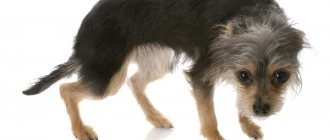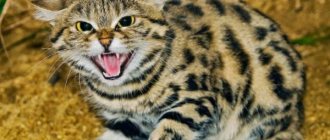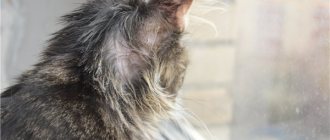The story of a rescue dog
According to legend, the Almighty watched the lives of desperate people living in snowy places on the island of Newfoundland. They fought against the cold and strong winds. And he decided to create an assistant for them, similar to a bear, but more resilient and energetic.
This is how Newfoundland dogs appeared on the island, which are adapted to the harsh climate and are not afraid of icy water, snow drifts, and severe frosts. Reliable companions of fishermen became their guardian angels in the trials of the elements of earth and water.
Reliable information about large dogs bred by the monks of the Alpine shelter of St. Bernard has been preserved from the 19th century to the present day. For travelers who got lost on the way during a snowstorm, animals were the last chance of salvation. Barrels of warm rum were tied around the dogs’ necks and they were sent out to find those who needed help.
The animals found people, warmed them with thick fur and brought wine, and then brought rescuers from the local monastery. History has preserved the name of Barry the dog, who saved four dozen lives over 12 years of work. One day the dog found a freezing child who had lost consciousness. Barry licked the baby so that the child would wake up while he waited for people to help.
Unfortunately, the last man to be saved by Barry stabbed the dog out of fear, confusing it with a bear. The dog survived, but could no longer serve people. After the death of the dog, grateful residents perpetuated her memory and erected a monument in the Paris cemetery. The breed of local dogs, descendants of Tibetan mastiffs, was called St. Bernards.
People have always admired and appreciated four-legged heroes. In the Pamir Mountains one and a half thousand years ago, ancient inhabitants made a rock painting in which a dog drags a weakened man. Museums around the world contain paintings with scenes dedicated to selfless animals.
The devotion and unique abilities of many breeds formed the basis for the preparation of trained dogs for special service. Despite the development of the latest technology, the search for people in many emergency situations, rubble after natural disasters, and collapses is better amenable to a dog’s sense of smell, the animal’s unique hearing.
One trained dog can replace the work of many people, and most importantly, quickly and effectively find the victim and help. There is a well-known experiment conducted by mountain rescuers. On an area of 10 thousand square kilometers they hid the “avalanche victim” at a depth of two meters. Rescuers consisting of 20 people searched for the man for 4 hours, and the dog found him in 12 minutes. Sometimes saving someone's life depends on the speed of assistance.
Features and history of the rescue dog
Representatives of the canine family, devoted to man, are called upon to serve him by nature. In exchange for their service, they received warmth, care and affection. Animals related to wolves were present in the lives of primitive people. They helped in the hunt, protected the home from wild animals, licked the owner’s wounds and warmed them with their warmth in severe frosts, and served as shepherds.
Rescue dog
Gradually, the ancestors of wild domesticated animals acquired the appearance and features of modern dogs. Previously, wild dogs have proven themselves not only to be devoted companions, but also to be hardy, strong guardian angels. This is how the first rescue dogs appeared.
Interesting! Dogs, demonstrating love for their owner, saved his life not only in battles with enemies, but also during floods or fires, found and pulled out from under snow rubble or collapsed buildings.
A devoted dog is able to intuitively sense danger, possessing an incredible sense of smell; he is able to sense the scent of his owner under a layer of snow several meters deep, and smell the burning smell of an approaching forest fire from a great distance.
Over time, dog breeds began to be artificially bred from the most capable representatives to save human lives during natural disasters, search and protect in extreme conditions. This practice proved effective because it required a four-legged rescuer less time to complete the task than a human in situations where the time to rescue was measured in minutes.
A dog trained to rescue from rubble
Rescue Dog Breeds
Not all animals are capable of being rescuers. A service dog must have a calm character, endurance, and internal strength to overcome obstacles. Although history knows examples of selfless service and heroic deeds of modest-sized four-legged pets. Cynologists identify some dog breeds with innate abilities to overcome difficulties. Among them the most famous are:
St. Bernard . A dog of impressive size with enormous physical strength. The unique abilities of animals are manifested in the perception of sound waves with a frequency of up to 100 Hz, i.e. Saint Bernards hear 4-5 times better than humans. The acuity of smell exceeds human capabilities by 14 times due to the special development of the nasal cavity.
The unique talent of animals makes it possible in mountainous regions to anticipate an avalanche by air movement several hours in advance and to warn people. It is no coincidence that St. Bernards are called avalanche dogs.
Thanks to their special sense and physical strength, dogs find people buried under a mass of snow, dig them out, warm them, pull them to a safe place or bring people to help. The Saint Bernard is the best rescue dog in the mountains , not backing down from obstacles and displaying an irresistible temperament.
Intellectual abilities, quick wit, resistance to stress, and devotion distinguish unsurpassed four-legged rescuers in the mountains. In ordinary life, dogs are the best guards, touching nannies for children, ready to rush to their protection.
Newfoundland (diver) . Dogs with a large torso and wide back, as if created by nature for physical work in difficult conditions. The unique anatomical structure allows Newfoundlands to be in icy water without harm to their health.
This is facilitated by the special structure of the ears, interdigital membranes, third eyelid, and wool that does not get wet in water. Water rescue dogs are distinguished by their ability to swim tens of kilometers, dive to great depths, resistance to cold, and the ability to instantly respond to a drowning person.
A strong nervous system and nobility allow you to serve in the police and be unsurpassed guides. But the main passion of dogs is the water element, without which the animal will not show its best qualities and capabilities.
German Shepherd . In the distant past, the ancestors of the modern breed protected livestock from predators. Modern dogs with developed intellectual abilities are universal in serving humans - they serve in the police, work in search and security services, and help in rescue operations. Dog handlers highlight the main features of the breed:
- nobility;
- determination;
- perseverance;
- activity.
The best qualities of dogs are revealed when pets are raised properly. The friendliness they show in the family is not characteristic of them towards strangers. Strong-willed character, fearlessness, and intelligence allow us to solve the most difficult problems in finding people under rubble, in mountainous areas, and in criminal incidents.
There is a known case of saving people from snow captivity, when the shepherd dog Ajax worked without rest for 96 hours until she freed the last person from under the compressed snow. The dog's paws were frostbitten and worn down to the bone.
Labrador. The entire history of the breed is connected with serving people during hunting and fishing. The endurance, physical strength, and balanced nature of the animals helped them survive storms, bad weather, and travel off-road. Thanks to their developed intelligence, dogs remember more than two hundred commands and understand people well.
An excellent sense of smell, fearlessness, and athletic build make dogs indispensable in search activities on land, water, and in the mountains. Service dogs search for prohibited and dangerous substances and help carry objects in the mouth without damage. Thus, Labrador retrievers delivered first aid kits with medicines to people in the rubble, crawling through the cracks at the risk of their lives to the victims so that they could provide themselves with first aid.
Doberman. For their harmonious physique, tall stature, and expressive silhouette, dogs are called aristocrats. High performance, strength, agility, endurance, and intelligence distinguish Dobermans when performing a variety of tasks.
Dogs are trained for reconnaissance, exploring caves, searching for climbers in the mountains, and working among rubble after earthquakes. Animals have an excellent sense of smell, developed observation, vigilance, and attentiveness. Dobermans with a proud character recognize strong and balanced people, whom they serve faithfully and selflessly.
Rottweiler. The dog's physical strength, developed senses, and sharp mind have long been valued. Since the Middle Ages in Europe, Rottweilers have been assigned the role of guards when transporting cargo and driving livestock. High adaptive abilities allow the animal to work at a given rhythm in harsh climate conditions.
A German dog, if properly trained, is always ready to help a person. The strong character of dogs requires constant attention from the owner, clear guidance in all matters, and competent socialization. In Scandinavian countries, Rottweiler dogs serve in forest and mountain rescue services.
Spaniel. Active, medium-sized dogs are distinguished by their agility and excellent sense of smell. Natural playfulness, responsiveness, and sociability make them everyone’s favorites. Their lean physique allows them to be used in extracting people from the rubble during natural disasters. The spaniel accurately determines whether a person is alive. Gives signals by barking or whining. Thanks to the dogs' tenacity in their work, many children were saved.
Alaskan Malamute. Dogs are known for their physical endurance, which is why they were used on expeditions to conquer the poles. The animals' strong constitution and well-developed muscles allow them to transport sleds with a load of up to 400 kg. Dogs are valued for their ability to navigate unfamiliar terrain, overcome snowdrifts, and dig deep holes.
The animal will unmistakably find and dig up a buried person under the snow crust, without harming him, deliver the wounded person to people, and will not leave him in trouble. Northern peoples cannot do without malamutes in search and rescue operations.
Cynologists believe that many breeds rescue dogs appear when the animals develop certain qualities and proper training, since nature already provides great potential capabilities for four-legged animals - acute vision, excellent hearing, sensitive sense of smell, endurance, intelligence.
Diver dogs with webbed paws save people on Moscow beaches
Photo: Andrey ABRAMOV
Sunday. The sun at its zenith melts Muscovites with ultraviolet light. The beach of the Stroginsky floodplain behind the Yantar stadium is strewn with townspeople. Swimming is prohibited here: the bottom changes are too sharp - up to 30 meters, and according to the norms, you can only enter the water in reservoirs where the depth evenly drops to two. But Muscovites still violate it: the heat, like an insidious tempting snake, calls for a dip.
Rescue dogs in Moscow patrol the beaches in Strogino.
Photo: Andrey ABRAMOV
Beautiful girls are rubbing oil on each other, kids are kicking a ball, men are hanging out on their phones with a concentrated look. And then powerful paws step along the beach. A Newfoundland named Abi went out on patrol with her owner. The entire beach instantly turns its gaze to the giant dog. Even if she is inferior to the lion in size, it is only slightly. But he looks very, very respectful - he’s wearing a bright life jacket over his pitch-black “fur coat.”
When Newfies come ashore, at first everyone is surprised by their size, and then they run to take pictures.
Photo: Andrey ABRAMOV
…
On weekends, Abi and other Newfoundlands patrol the beaches in Strogino. Their owners are volunteers who come to the Moscow search and rescue service base every weekend. The shift always begins with training, and then the dogs go out into the fields.
Abi has real-life experience rescuing drowning people.
Photo: Andrey ABRAMOV
It is almost impossible to train this breed for the “front” command.
Photo: Andrey ABRAMOV
At first, vacationers watch the black giant warily. But soon a crowd gathers around the dog. Everyone wants to take a photo with an animal, but she doesn’t mind. Shaggy Abi has a stern appearance, but a kind heart of a dog.
Owners and dogs spend the entire weekend training and on patrol.
Photo: Andrey ABRAMOV
At first, puppies may be afraid to go into the water.
Photo: Andrey ABRAMOV
Huge Newfoundland dogs are very friendly to people by nature. They were once bred as a working breed for the harsh northern regions (this was in Canada). And today - well, where can you adapt this furry cuteness in an urban environment? And with powerful swimming skills too. Therefore, a water rescue team is just what you need.
All dogs wear vests to help them float on the water.
Photo: Andrey ABRAMOV
— When we appear, there is no one in the water. Everyone is running to take pictures! So we save people very well,” jokes the head of the Soter kennel club, Alexander Burmistrov.
YUMMYS - THE ENGINE OF PROGRESS
“We now have 15 pets coming to study with us,” continues Burmistrov. — Large dogs used to help fishermen pull out nets and people. To pull a person, the dog must be large - at least 50 kilos. These ones reach 70 kg.
Diver dogs reach a weight of 60-70 kg.
Photo: Andrey ABRAMOV
Divers - this is the second name of the breed - are naturally given webbed paws. A rare genetic trait that allows for excellent swimming. The muzzle is also unusual: when another dog swims and starts snorting, water fills the nasopharynx. Newfoundlands do not suffer from this. Their quills—dog lips hanging down along the edges of the lower jaw—are of a special shape. The liquid pours back out.
The breed's jaws are designed in such a way that water pours back out rather than flooding the mouth.
Photo: Andrey ABRAMOV
But all this does not mean that Newfies can swim from childhood.
While Abi patrols the beach, her colleagues train at the base. Six-month-old puppies, the size of an adult German Shepherd, are just being taught to go into the water. Some people are cowardly, so they use treats: swim a meter and back - get a treat. Then they are taught to go further and further.
With short rest breaks on land, the dog can spend the entire day on the water.
Photo: Andrey ABRAMOV
— Water is an aggressive environment and without obedience skills you can’t do anything with a dog. Newfies are rescuers just like people - they constantly need training. We practice all year round. In winter at the training ground, and in summer at the rescue station. Strong paws, good reaction, knowledge of commands - that’s what you need to get into the squad, says Burmistrov.
Before going to work as a rescuer, the animal must take obedience courses.
Photo: Andrey ABRAMOV
When the dog ceases to be afraid of water, exercises are introduced into the training. For example, dragging a lifeless body - a person sprawled on the surface of the water. Divers are also taught to collect floating objects, and in such a way that they do not bite, but only carefully take them into their mouths. This is necessary so that the dog gently pulls the person’s limb.
The dog bites the hand so as not to hurt it.
Photo: Andrey ABRAMOV
PEOPLE DROWN IN SILENCE
The data of four-legged divers is colossal. They are capable of pulling a 700 kilo boat through the water by a rope - this is a boat with five passengers.
- Only a very trained person in fins and a wetsuit can repeat this. Dogs are not so quick to help. But they have more power. The animals work steadily, but under no circumstances will they drown themselves or you. Newfies are kind. It is almost impossible to train the “front” command. Even when defending the owner, they will do it with their voice and not attack. And the bark is as big as the roar of a lion,” Vladimir Eroshin, head of the Strogino PSS, told Komsomolskaya Pravda.
They train in various exercises: according to legend, a rope in the teeth must be given to people on a boat so that they can be pulled to the shore.
Photo: Andrey ABRAMOV
Experts explain:
— If something happens to you on the water and the rescue dog is the first one nearby, you don’t need to try to help him with anything.
— Correct actions: calmly grab the life jacket the animal is wearing, relax and swim out on it.
“It’s interesting that when patrolling beaches, dogs pay attention to the behavior of swimmers, and not to screams.
— People are drowning in silence. When a person goes to the bottom, he does not scream at all - this is a myth, says Eroshin. — Dogs read gestures: frequent waves of arms in different directions, slaps in the water, splashes.
Diving dogs are trained to swim around a drowning person from the right side and position themselves so that the person grabs with the left - after all, most people are right-handed and it will be convenient for them to scoop up with their working hand. The dog vests have a handle that you can hold on to.
A drowning person can grab onto the dog's vest and the animal will swim to the shore.
Photo: Andrey ABRAMOV
YOU WILL GET A NEWF AND YOU WILL NOT WANT OTHERS ANYMORE
“We just went out to patrol, and an Uzbek boy runs towards us.” His friend decided to learn to swim. I tied myself with plastic bottles and went into the water. The current carried him 300 meters from the shore, and he found himself in the middle of the river. He’s no longer visible, just snippets of screaming,” recalls Abi’s owner, Natalya Afanasyeva.
Natalya has three Newfies living at home.
Photo: Andrey ABRAMOV
At the command “Forward, help!” — the dog rushed into the water. She swam around the rest of the vacationers and reached the drowning guy. A few more seconds and he would have choked: he was already in a semi-fainting state and could not even grab onto the dog. At this moment, Abi’s owner, Natalya’s husband, also swam.
Dogs can stay in water for a long time. With breaks on the shore, the animal is able to swim all day. With proper training, they can dive to depths of up to six meters. If you buy a dog with a good pedigree - only Newfoundlands in the family - it costs about 60 thousand rubles.
“If you get a Newfie, you won’t want any other dogs,” says Natalya. - They are like people, but they don’t talk, their intelligence is very high. We come here on weekends - this is our vacation. And dogs find it interesting - they live for it. You can see from them that when we do a new exercise, the dog shakes with joy.
ON A NOTE
How to make a dog a rescuer
You can bring your dog to Soter to train from an early age. The age limit for rescue dogs is up to eight years. There are no set membership fees. Participants chip in for equipment as needed. Even if you don’t have a dog, but you really want to help in the kennel club, you will be welcome here. Phone number of the manager (Alexander).
What qualities and characteristics are inherent in a rescue dog?
Search and rescue services select dogs of various breeds with certain characteristics for training. If an animal is being prepared to work under rubble, then the requirements for external characteristics are:
- small size - the dog needs to penetrate small holes;
- medium-length wool - in rubble there is a high risk of injuring the skin.
The best rescue dogs are:
- muscular physique – requires physical strength to perform heavy work;
- endurance - solving rescue problems cannot be delayed;
- stress resistance – heavy loads are inevitable in rescue operations;
- strong-willed character - it is important for the dog to achieve its goal;
- fearlessness – work involves a constant risk of injury;
- stable psyche - in achieving the goal, dogs should not be distracted by extraneous factors (smells, screams), or work with devices attached to the body;
- intelligence – smart animals not only follow commands, but make decisions themselves in difficult situations;
- good nature - love for people is the basis of rescue work;
- high socialization - work efficiency depends on the ability to contact many people and other animals.
Rescue dogs of the Ministry of Emergency Situations, based on natural characteristics and proven work skills, specialize in the following areas:
- search and rescue;
- mountain avalanche search;
- mine detection work;
- search for bodies;
- rescuing people on the water;
- searching for a person using a scent trail.
Natural skills and skills strengthened during training are checked by special tests, which begin to be carried out on puppies from 3 months.
Mountain rescuers
Mountains are considered one of the most difficult places to work. Low temperatures, strong winds, as well as sudden changes in weather conditions require unprecedented endurance from animals and humans. To work in the mountains, strong, large animals are used to be able to get a person out of the rubble or bring equipment. Their coat should be thick, with a dense undercoat, which protects them from low temperatures.
Saint Bernard
These dogs have been rescuing climbers in the mountains for several centuries. Initially, they were used for protection by the servants of the monastery of St. Bernard in the Swiss Alps (XVII century), hence the name of the breed (Saint-Bernard).
Over time, climatic conditions in the Alps began to change and cases of snow melting became more frequent. Saint Bernards began to be used not only as guards, but also as escorts when crossing the mountains. They have a flexible disposition and endurance, so they were often used as pack animals for transporting goods. Their ability to predict avalanches often saved the lives of travelers.
Saint Bernards are very affectionate, calm and friendly. They treat small children with care and patience, are not afraid of strangers and react calmly to other animals. They are not aggressive and will not bark without a reason. However, if threatened, their instincts will react quickly.
Saint Bernards are intelligent and trainable. They have an excellent sense of smell, capable of sensing a person at great depths under the snow. They are able to dig out the victim and signal his location to the rest of the rescue team.
Dogs of this breed are large and powerful. Their average height is 80 cm, and their weight is more than 70 kg. They have thick, long or short (depending on the breed type) coat with undercoat. This coat allows them to withstand cold temperatures and can help warm injured climbers.
German Shepherd
The German Shepherd is one of the most popular working dogs. It is used in various spheres of human life (security, police, military service, etc.). These dogs also help climbers and other victims of various disasters.
German Shepherds are versatile. They cope well with search operations, both in the mountains (in cases of snowfalls) and in the lowlands after earthquakes and other disasters, looking for people under the rubble.
German Shepherds are suitable in all respects for working in special operations in the mountains:
- they are smart and easy to train;
- balanced, psychologically stable;
- quickly adapt to unfamiliar surroundings and navigate the terrain;
- withstand cold weather;
- have good health.
The average height of a shepherd dog is 50-60 cm, and weight is 50 kg. She has an excellent sense of smell, vision and hearing, which allows her to find the victim at great depths. At the same time, trained shepherd dogs are able not to be distracted by extraneous smells and noises, concentrating on searching work.
German Shepherds have a powerful muscular corset and strong paws. This helps them dig a person out of the rubble. And well-developed sense organs make it possible to guide the victim to a safe place (shepherd dogs are also often used as guides for blind people).
Rescue dog training
The innate qualities of an animal are fully revealed only with proper upbringing and a system of constant training. It is impossible to correct the trainer’s mistakes during the pet’s puppyhood later.
Search and rescue service with the participation of four-legged assistants, the domestic method of training service dogs is one of the best in the world. The dogs are trained to overcome obstacles, move inside ruins, and act in complete darkness and in harsh weather conditions. Training is carried out in simulated situations of explosion, flooding, fuel leaks, and earthquakes.
Dogs learn to carry equipment, crawl, swim, and be with a person in a boat, on an airplane, or in a helicopter. Animals are hardened during hikes and overnight stays in open spaces. Training a rescue dog involves developing skills in terrain orientation, overcoming obstacles, and searching the area.
For training, different areas with varied terrain are selected, the load is calculated so that the dogs are not overtired, and the tasks of finding objects with a certain smell are gradually made more difficult.
Dog handlers know that a successful search for 1-2 complex objects is more effective than 10-12 simple finds. Dogs are rewarded for successful decisions with special treats to maintain the dog’s interest and persistence.
What can a rescue dog do?
Rescue dogs are able to search for missing people and save them in critical situations. A service dog searches large areas in a short period of time and moves over rough terrain, not paying attention to pitch darkness and bad weather conditions. People are searched for:
- on the rubble;
- on dams;
- in the place of earthquakes and natural disasters, etc.
A rescue dog can search for victims without a leash or collar. The specialist only supplies the animal with a special device (the puppy must also have a chip). The pet is not afraid of the stench of gas, fire and acrid smoke. Brave heroes move independently and make decisions quickly. They can work, rescuing victims, both in the sultry heat and in the cold season.
Most rescue breeds were bred to help rescuers find and protect people in emergency situations. Four-legged rescue friends are naturally endowed with keen hearing, courage and excellent intuition. Reliable dogs will always come to the rescue and will not leave you in trouble.
Interesting Facts
about rescue dogs that they are like guardian angels of people during periods of natural disasters, as they appear where a person plunges into a hopeless state. It takes an average of one and a half years to train one four-legged rescuer.
Experts do not cull dogs based on breed. A talented “mongrel” can be more capable than a purebred puppy with a pedigree. Interestingly, the mechanism for finding a person by smell has not been fully studied, so it is not possible to replace a dog with a device.
One rescue dog replaces 20-30 professional searchers. The most effective work is carried out in cloudy and night time - the animal picks up odors better. In one working day, a dog is able to survey an area of 1 sq. km.
Service dogs, due to workload and increased concentration, “retire” earlier and simply become favorites of their owners if they remain alive in tragic trials. The life of four-legged heroes is shorter than that of pets.
There is no greater joy for a search dog than rescuing a living person. In 2001, after the collapse of the Twin Towers, service dogs experienced severe depression along with people - they were not found alive. Unfortunately, the animals are not eligible for awards, but rescues honor all outstanding dogs.
Thus, residents of Beslan remember the Labrador Bernie with rescuer Alexei Bochkarev; residents of Kazan, after a fire in a shopping mall, remember the Belgian shepherd Farta, who received burns but did the job. The rescue dogs in the photo remind everyone of their heroic deeds for the sake of human life. These are probably the only creatures that love people more than themselves.
TOP 3 water rescue dogs
Many dogs love water, are excellent swimmers, and have a human-saving instinct. However, if there are dog breeds that learn to work on water as quickly as possible.
Newfoundland (not to be confused with diver). A unique breed of dog that has membranes between its paws. Representatives of the breed love water, but are well trained in other professions. The Diver is a breed developed in Russia from Newfoundlands. Unfortunately, the breed was never brought to fruition, so it is considered a service breed.
Labrador is originally a hunting gun dog. Today, Labradors are considered as companion dogs. The advantage of the breed is its exceptional people-orientation. Labradors can learn literally any skill if they help their owner.
The Leonberger is a noble, gigantic dog with a keenly developed instinct for saving people. Representatives of the breed are excellent swimmers and behave calmly in the water, so they are often used for work in rescue services. By the way, the Leonberger, like the Newfoundland, has membranes between its toes.
This is interesting! Theoretically, any pointing dog can work as a lifeguard on the water, since from birth it knows that what swims in the water (fetch, wounded animal, animal, person) needs to be retrieved.











